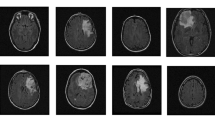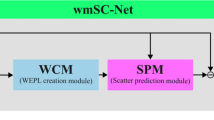Abstract
Somatostatin receptor scintigraphy (SRS) is an essential examination for the diagnosis of neuroendocrine tumors (NETs). This study developed a method to individually optimize the display of whole-body SRS images using a deep convolutional neural network (DCNN) reconstructed by transfer learning of a DCNN constructed using Gallium-67 (67Ga) images. The initial DCNN was constructed using U-Net to optimize the display of 67Ga images (493 cases/986 images), and a DCNN with transposed weight coefficients was reconstructed for the optimization of whole-body SRS images (133 cases/266 images). A DCNN was constructed for each observer using reference display conditions estimated in advance. Furthermore, to eliminate information loss in the original image, a grayscale linear process is performed based on the DCNN output image to obtain the final linearly corrected DCNN (LcDCNN) image. To verify the usefulness of the proposed method, an observer study using a paired-comparison method was conducted on the original, reference, and LcDCNN images of 15 cases with 30 images. The paired comparison method showed that in most cases (29/30), the LcDCNN images were significantly superior to the original images in terms of display conditions. When comparing the LcDCNN and reference images, the number of LcDCNN and reference images that were superior to each other in the display condition was 17 and 13, respectively, and in both cases, 6 of these images showed statistically significant differences. The optimized SRS images obtained using the proposed method, while reflecting the observer's preference, were superior to the conventional manually adjusted images.












Similar content being viewed by others
References
Tsuchikawa T, Takeuchi S, Hirata K. Current treatment trends and perspectives in neuroendocrine tumors (NET). Ther Res. 2022;43(11):901–10 ((in Japanese)).
Yao JC, Hassan M, Phan A, et al. One hundred years after “carcinoid”: epidemiology of and prognostic factors for neuroendocrine tumors in 35,825 cases in the United States. J Clin Oncol. 2008;26(18):3063–72. https://doi.org/10.1200/JCO.2007.15.4377.
Modlin IM, Lye KD, Kidd M. A 5-decade analysis of 13,715 carcinoid tumors. Cancer. 2003;97(4):934–59. https://doi.org/10.1002/10.1002/cncr.11105.
Dasari A, Shen C, Halperin D, et al. Trends in the incidence, prevalence, and survival outcomes in patients with neuroendocrine tumors in the United States. JAMA Oncol. 2017;3(10):1335–42. https://doi.org/10.1001/jamaoncol.2017.0589.
Masui T, Ito T, Komoto I, et al. Recent epidemiology of patients with gastro-entero-pancreatic neuroendocrine neoplasms (GEP-NEN) in Japan: a population-based study. BMC Cancer. 2020;20(1):1104. https://doi.org/10.1186/s12885-020-07581-y.
Kurita Y, Kuwahara T, Mizuno N, et al. Utility of somatostatin receptor scintigraphy in pancreatic neuroendocrine neoplasms. Suizo. 2019;34(2):78–85. https://doi.org/10.2958/suizo.34.78.(inJapanese).
Schaefferkoetter J, Yan J, Ortega C, et al. Convolutional neural networks for improving image quality with noisy PET data. EJNMMI Res. 2020;10(1):105. https://doi.org/10.1186/s13550-020-00695-1.
Sohlberg A, Kangasmaa T, Constable C, et al. Comparison of deep learning-based denoising methods in cardiac SPECT. EJNMMI Phys. 2023;10(1):26. https://doi.org/10.1186/s40658-023-00531-0.
Ura S. An analysis of a paired comparison experiment. Hinshitsu-Kanri (Quality Control). 1959;16:78–80 ((in Japanese)).
Shin HC, Roth HR, Gao M, et al. Deep convolutional neural networks for computer-aided detection: cnn architectures, dataset characteristics and transfer learning. IEEE Trans Med Imaging. 2016;35(5):1285–98. https://doi.org/10.1109/tmi.2016.2528162.
Nosato H. A platform for ai-based image diagnostic support in endoscopy. J Japan Soc Laser Surg Med. 2022;42(4):237–45. https://doi.org/10.2530/jslsm.jslsm-42_0023.
Krenning EP, Valkema R, Kooij PP, et al. Scintigraphy and radionuclide therapy with [indium-111-labelled-diethyl triamine penta-acetic acid-D-Phe1]-octreotide. Ital J Gastroenterol Hepatol. 1999;31(Suppl 2):S219–23.
Mao X-J, Shen C, Yang Y-B. Image Restoration Using Convolutional Auto-encoders with Symmetric Skip Connections. Adv Neural Inform Process Syst. 2016;29:1–17. https://doi.org/10.48550/arXiv.1606.08921.
Tong T, Li G, Liu X, Gao Q. Image super-resolution using dense skip connections. IEEE Int Conf Comp Vis. 2017;2017:4809–17. https://doi.org/10.1109/ICCV.2017.514.
Scheffé H. An analysis of variance for paired comparisons. J Am Stat Assoc. 1952;47(259):381–400. https://doi.org/10.2307/2281310.
Shiraishi J, Okazaki Y, Goto M. Image evaluation with paired comparison method using automatic analysis software: comparison of ct images with simulated levels of exposure dose. Nihon Hoshasen Gijutsu Gakkai Zasshi. 2019;75(1):32–9. https://doi.org/10.6009/jjrt.2019_jsrt_75.1.32.(inJapanese).
Tukey JW. Comparing individual means in the analysis of variance. Biometrics. 1949;5(2):99–114. https://doi.org/10.2307/3001913.
Dittrich RP, De Jesus O, Gallium Scan. StatPearls [Internet]. 2023 Jan. https://www.ncbi.nlm.nih.gov/books/NBK567748/.
Sun Y, Liu X, Cong P, Li L, Zhao Z. Digital radiography image denoising using a generative adversarial network. J Xray Sci Technol. 2018;26(4):523–34. https://doi.org/10.3233/XST-17356.
Acknowledgements
We would like to thank Editage (www.editage.jp) for the English language editing.
Funding
PDRadiopharma Inc.
Author information
Authors and Affiliations
Corresponding author
Ethics declarations
Conflict of interest
Co-investigator Junji Shiraishi was supported in part by a research grant from PD Radiopharma Inc.
Ethics approval
Ethical approval for case use was obtained from the institutional review board (IRB) of both the authors’ institutions.
Additional information
Publisher's Note
Springer Nature remains neutral with regard to jurisdictional claims in published maps and institutional affiliations.
About this article
Cite this article
Matsumoto, S., Nakahara, Y., Yonezawa, T. et al. Development of an individual display optimization system based on deep convolutional neural network transition learning for somatostatin receptor scintigraphy. Radiol Phys Technol 17, 195–206 (2024). https://doi.org/10.1007/s12194-023-00766-7
Received:
Revised:
Accepted:
Published:
Issue Date:
DOI: https://doi.org/10.1007/s12194-023-00766-7




